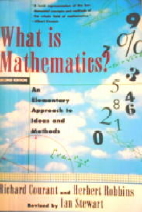I recently got a copy of Daniel Tammet’s latest book, Thinking in Numbers. As you may know, Daniel Tammet has been described as a high functioning autistic savant. He gained some notoriety in 2004, when he recited the decimal expansion of pi to 22,514 places in just over 5 hours. You can see him do some of his remarkable calculations on this video. He is now the author of three books – Born on a Blue Day, Embracing the Wide Sky, and this one. He also has a blog which can be found here.
One of the more important things about Tammet’s story is his own view of his extraordinary abilities. He is convinced that what he can do is an extreme variation of something we all do. He can do what he does because of the rich and complex associativity that is thinking and imagination. Since Tammet can accomplish startling calculations, making use of the color and shape of the numbers he sees, his experience addresses both what mathematics is as well as what the imagination can do.
Here is a nice excerpt from the preface:
Imagine.
Close your eyes and imagine a space without limits, or the infinitesimal events that can stir up a country’s revolution. Imagine how the perfect game of chess might start and end: a win for white, or black or a draw? Imagine numbers so vast that they exceed every atom in the universe, counting with eleven or twelve fingers instead of ten, reading a single book an infinite number of ways.
Such imagination belongs to everyone. It even possesses its own science: mathematics. Ricardo Nemirovsky and Francesca Ferrara, who specialize in the study of mathematical cognition, write that, ‘Like literary fiction, mathematical imagination entertains pure possibilities.’ This is the distillation of what I take to be interesting and important about the way in which mathematics informs imaginative life. Often we are barely aware of it, but the play between numerical concepts saturates the way we experience the world.
Tammet’s book is a collection of 25 eclectic essays, many of which trigger thoughts that I have been exploring in these blogs. In one of the essays, called Einstein’s Equations, he writes the following:
Human beings’ quest for meaning is perpetual; lack of meaning is offensive to the mind, and whatever the scale of the problem, a solution is a thing of beauty. Einstein’s equations solved problems such as ‘What do we mean by the words “time’ and “mass”?’
Answering this question ‘what do we mean by…?” doesn’t just reveal something about time and mass, it also reveals something about us. I believe that this ‘perpetual quest for meaning’ is not an intellectual event. It begins deep within some of the most fundamental attributes of the human organism, like vision itself. Vision itself is a quest for meaning, for order and recognition. Sensory processes bring structure to sensory data and within the complex associative actions of the nervous system we finally perceive the world as well as our thoughts. In the light of embodied cognition, the roots of something as purely symbolic as mathematics are found in the body’s action. I looked up a paper written by the individuals Tammet references in his preface -Ricardo Nemirovsky and Francesca Ferrara. The paper is called Mathematical imagination and embodied cognition.
They begin with the statement Tammet makes in his preface and follow up with interesting observations.
Like literary fiction, mathematical imagination entertains pure possibilities. However numerous traits distinguish them. The one that we want to emphasize here is that the possibilities held by mathematical imagination are regulated by or embedded in, a sense of logical necessity in all its deductive and inductive modalities.
Then, a little later:
Whatever we recognize as rational, rule-based, or inferential, is fully embedded in our bodily actions; perception and motor activity do not function as input and output for the “mental” realm; what we usually recognize as mental are inhibited and condensed perceptuo-motor activities that do not reach the periphery of our nervous system…Any perceptuo-motor activity is inscribe in a realm of possibilities encompassing all those for which the subject achieves a certain state of readiness. In this sense all animals imagine, not just humans, although it is not clear to what extent non-human animals entertain pure possibilities.
Tammet’s book covers so much ground, and his experience is so unusual, I’m sure I will write again about some of his thinking in numbers. In Tammet’s stories, mathematics pervades human lives and one of the moments I particularly enjoyed was this quote from Vladimir Nabokov:
Reality is a very subjective affair….You can get nearer and nearer, so to speak, to reality; but you never get near enough because reality is an infinite succession of steps, levels of perception, false bottoms, and hence unquenchable, unattainable. You can know more and more about one thing but you can never know everything about one thing: it’s hopeless.
I would end this thought differently. This asymptotic approach to reality is no doubt, hopeful. Because there is always more.


I got it from a book seller associated with amazon.com, then noticed yesterday that they were saying it was unavailable. But it is today!
I find Tammet fascinating and haven’t seen the latest book in a bookstore here(U.S.) even though his first two were big sellers; so just curious if you special ordered it, got it online, received a review copy, or did find it in a store in your area?